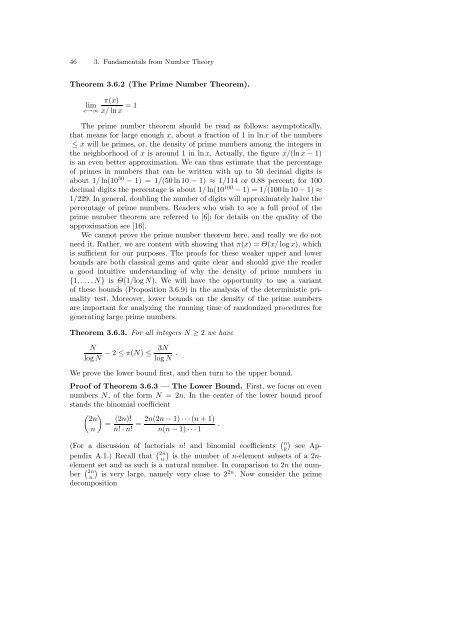Dietzfelbinger M. Primality testing in polynomial time ... - tiera.ru
Dietzfelbinger M. Primality testing in polynomial time ... - tiera.ru
Dietzfelbinger M. Primality testing in polynomial time ... - tiera.ru
You also want an ePaper? Increase the reach of your titles
YUMPU automatically turns print PDFs into web optimized ePapers that Google loves.
46 3. Fundamentals from Number Theory<br />
Theorem 3.6.2 (The Prime Number Theorem).<br />
π(x)<br />
lim<br />
x→∞ x/ ln x =1<br />
The prime number theorem should be read as follows: asymptotically,<br />
that means for large enough x, about a fraction of 1 <strong>in</strong> ln x of the numbers<br />
≤ x will be primes, or, the density of prime numbers among the <strong>in</strong>tegers <strong>in</strong><br />
the neighborhood of x is around 1 <strong>in</strong> ln x. Actually, the figure x/(ln x − 1)<br />
is an even better approximation. We can thus estimate that the percentage<br />
of primes <strong>in</strong> numbers that can be written with up to 50 decimal digits is<br />
about 1/ ln(10 50 − 1) = 1/(50 ln 10 − 1) ≈ 1/114 or 0.88 percent; for 100<br />
decimal digits the percentage is about 1/ ln(10 100 − 1) = 1/(100 ln 10 − 1) ≈<br />
1/229. In general, doubl<strong>in</strong>g the number of digits will approximately halve the<br />
percentage of prime numbers. Readers who wish to see a full proof of the<br />
prime number theorem are referred to [6]; for details on the quality of the<br />
approximation see [16].<br />
We cannot prove the prime number theorem here, and really we do not<br />
need it. Rather, we are content with show<strong>in</strong>g that π(x) =Θ(x/ log x), which<br />
is sufficient for our purposes. The proofs for these weaker upper and lower<br />
bounds are both classical gems and quite clear and should give the reader<br />
a good <strong>in</strong>tuitive understand<strong>in</strong>g of why the density of prime numbers <strong>in</strong><br />
{1,...,N} is Θ(1/log N). We will have the opportunity to use a variant<br />
of these bounds (Proposition 3.6.9) <strong>in</strong> the analysis of the determ<strong>in</strong>istic primality<br />
test. Moreover, lower bounds on the density of the prime numbers<br />
are important for analyz<strong>in</strong>g the <strong>ru</strong>nn<strong>in</strong>g <strong>time</strong> of randomized procedures for<br />
generat<strong>in</strong>g large prime numbers.<br />
Theorem 3.6.3. For all <strong>in</strong>tegers N ≥ 2 we have<br />
N<br />
3N<br />
− 2 ≤ π(N) ≤<br />
log N log N .<br />
We prove the lower bound first, and then turn to the upper bound.<br />
Proof of Theorem 3.6.3 — The Lower Bound. First, we focus on even<br />
numbers N, oftheformN =2n. In the center of the lower bound proof<br />
stands the b<strong>in</strong>omial coefficient<br />
� �<br />
2n<br />
=<br />
n<br />
(2n)! 2n(2n − 1) ···(n +1)<br />
= .<br />
n! · n! n(n − 1) ···1<br />
(For a discussion of factorials n! and b<strong>in</strong>omial coefficients � � n<br />
k see Appendix<br />
A.1.) Recall that � � 2n<br />
n is the number of n-element subsets of a 2nelement<br />
set and as such is a natural number. In comparison to 2n the number<br />
� � 2n<br />
2n<br />
n is very large, namely very close to 2 . Now consider the prime<br />
decomposition












